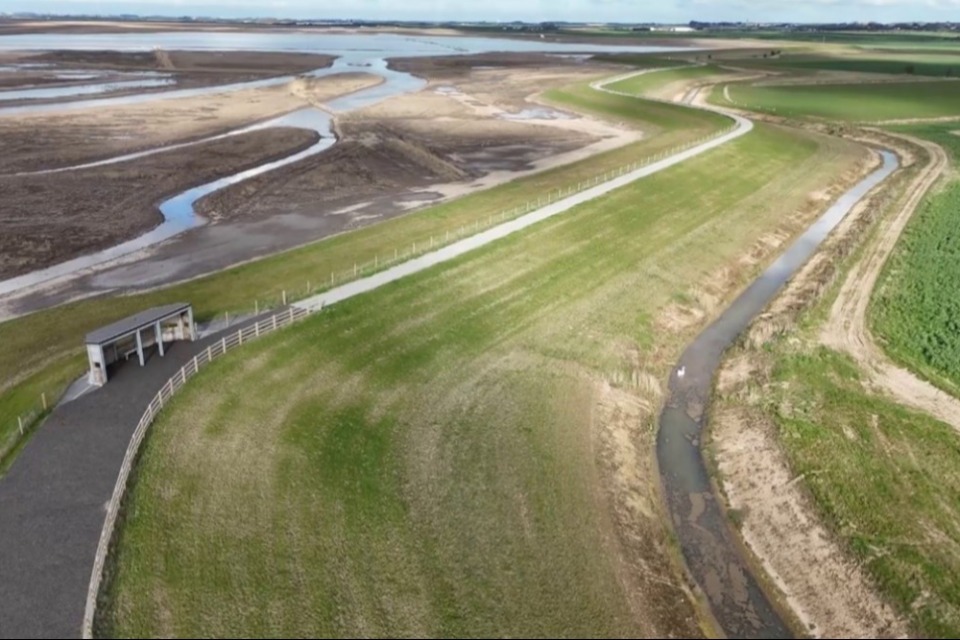The Outstrays Managed Realignment Scheme (OMRS) at the Humber Estuary in Yorkshire has been delivered by the Environment Agency, in collaboration with Associated British Ports (ABP), working together with many other organisations.
The project, designed and built by JBA Bentleys, is creating a vast new 250-hectare area of habitat
- 175 hectares is intertidal habitat (saltmarsh and mudflats).
- 75 hectares is terrestrial freshwater ‘wet grassland’.
Much of the new habitat is compensatory habitat. Its creation replaces important intertidal habitat lost as a result of flood risk management work and port development in other parts of the estuary.
Strategically, OMRS has enabled improvements to tidal defences that benefit more than 100,000 people, industry and infrastructure around the estuary, including in Hull, Hessle, South Ferriby and Stallingborough. It will also facilitate future port expansion by ABP.
The Environment Agency is supporting the government’s mission for growth our flood risk management programme delivers significant economic benefits by protecting vital infrastructure and creating investment confidence.
New Intertidal Habitat
The new intertidal habitat at Outstrays has been created by building a state-of-the-art new 5.5km flood embankment and creating a breach in the old defence that allows the tide to flow in and out of the ‘basin’ created in between. The new embankment helps reduce flood risk to property and farmland in South Holderness.
We have also created other new habitats, including the wet grassland, new hedgerows and tree planting as well as preserving dune habitat. These all complement the intertidal areas, increasing biodiversity.
The Environment Agency has invested £35.5m delivering the improved flood defences, new habitat and improved public access, with an additional contribution of £9.8m from ABP. A further £11m is being invested in two new pumping stations (to be completed by 2027).
Environment Agency Chair, Alan Lovell, said
We know the devastating impact that flooding can have, which is why protecting people and communities is our top priority.
The delivery of the Outstrays Managed Realignment Scheme is a significant milestone, enabling both the creation of major flood defences in Humberside and providing vital wetland habitat for migratory birds.
Without this project, our vital ongoing investment to reduce tidal flood risk to the homes, businesses and industry across the Humber could not happen, demonstrating the power of engineering and nature working hand-in-hand.
Alan Lovell unveils an interpretation board during an event to celebrate the completion of the Outstray Managed Realignment Scheme.
Throughout the scheme development and delivery, there has been a huge amount of engagement with the local community and wider organisations with regular updates through newsletters, a website, drop-ins, meetings and site visits, including delivering projects in local schools.
Access For All
The Environment Agency’s Humber Strategic Manager, Helen Todd, said
This project and the learning from it contribute towards the longer-term goals of managing tidal flood risk as part of Humber 2100+, which will set the way forward in adapting to sea level rise for the next 100 years.
The design and delivery of the project have been adapted to meet local needs where possible, for example changing the line of a footpath and designating it as a bridleway to allow people to continue to experience the amazing estuary views.
We want people to enjoy the benefits of this amazing site and learn about the new habitats created.
To facilitate that learning, the scheme is creating two new car parks for visitors; four bird hides; a new bridleway with ‘Access For All’ surfacing at key sections; and a series of interpretation boards. The main path around the site is part of the King Charles III England Coast Path.
Two new pumping stations will be completed in 2026 and 2027, replacing older ones at Skeffling and Winestead Outstrays. Their increased capacities and carbon efficiency will make an important contribution to the management of flood risk for local residents, businesses and farmland.
Andrew Dawes, Regional Director of Associated British Port (Humber) said
This scheme represents a major milestone, not just in terms of engineering and environmental achievement, but in what it means for the future of the Humber region.
These landscapes are not only beautiful — they’re vital. ABP’s investment in this scheme reflects our long-term commitment to the Humber and its communities, enabling investment and job creation.
Developing new estuarine habitat like this is a crucial way of ensuring that potential environmental impacts from the development of future port infrastructure can be offset and, consequently, this project is a powerful example of how infrastructure and nature can work hand in hand.
It supports the Humber’s role as the UK’s gateway for trade, while also enhancing flood resilience and we already have nationally significant projects in development, ready to start construction, that are linked to the site.
Nick Lister, Director at JBA Bentley, said
JBA Bentley are proud to have collaborated closely with two of our key clients – the Environment Agency and Associated British Ports – to deliver this important managed realignment scheme at The Outstrays.
As a fully integrated design-and-build business, our engineering, environmental, and construction teams worked with a range of partners and stakeholders to provide the detailed design and implementation of more than 175ha of intertidal habitat and supporting freshwater grassland.
This flagship project – which will ensure that the unique environment of the Humber Estuary is preserved for future generations – has provided great opportunities for social value, carbon reduction and innovative flood embankment construction.
Further to the successful delivery of the managed realignment scheme, JBA Bentley are delighted to have been awarded the upgrade of the adjacent Skeffling and Winestead pumping stations.

